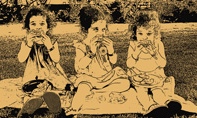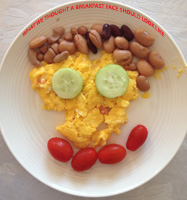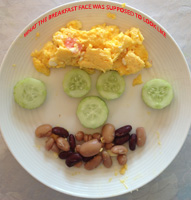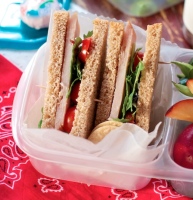- About Us
- Columns
- Letters
- Cartoons
- The Udder Limits
- Archives
- Ezy Reading Archive
- 2024 Cud Archives
- 2023 Cud Archives
- 2022 Cud Archives
- 2021 Cud Archives
- 2020 Cud Archives
- 2015-2019
- 2010-2014
- 2004-2009
 |
Keeping It Together- |
There are a few things in life that make me incredibly anxious.
1. Asking a sales person for a ‘better price’ on something.
2. Being made to talk to relatives from overseas on the phone. Even though I am assured that they ‘only want to say hello’, I know full well that they expect a full conversation and I would be imminently faced with the feeling of failure that my completion of Level 7 Modern Greek has not helped me as much as I hoped in mastering an impossibly difficult language.
3. Being alone in an elevator.
4. Being with other people in an elevator.
5. Being underneath things that could fall / collapse on me e.g. while reaching for something that has rolled underneath the bed or sleeping on the bottom bunk.
6. Stairs with no railings.
7. The thought of getting a paper cut on my eye.
Above all these completely rational reasons to get anxious, there is one that tops them all - serving food to offspring. My aim is to impart a life lesson that I have never come across in any parenting book – that children have ideas and expectations of acceptable food presentation based on a set of rules and preferences which are completely rational to them but we as parents cannot understand nor successfully abide by them. Some issues arise due to the way food is used and handled, although issues emerge mostly due to children’s ever changing yet consistent need to control the way food is presented to them. After all, even chocolate-dipped food comes with its own debacles if it is not done correctly.
As a general rule, it is imperative not to help children do anything that cannot be undone if there is a possibility that they may have wanted to do it themselves. For example, open a lunch box lid, slice a piece of cheese, or of course, peel a banana. If a child is asked whether they would like a banana and they say 'yes', proceeding to peel it without confirmation usually does not end favourably. Depending on the offspring's mood, the action may pass with minimal fuss, but there is a greater chance that the process will end in tears - most likely, the parent’s. A child must always be given the opportunity to peel their own banana, even if past experience (and the kitchen or car floor) has proven this action unsuccessful.
There can be exceptions, however, whereby a banana is given to offspring unpeeled, the gesture can sometimes be met with screams of offence and implied accusations of one’s overall ability to parent. How could parents possibly expect a child to complete a task such as peeling their own banana? The audacity. This is likely to happen when a child is involved in a task that they do not want to be interrupted in doing such as playing on the iPad, or in the event that the offspring’s extensive activity throughout the day has made their hands ‘too tired’.
It is also absolutely imperative to make sure that prior to peeling a banana, there is a very clear guideline as to the exact specifications of the peeling process – having peeled it beyond the point of recovery can be disastrous if offspring deem it too far down. Furthermore, one must always be careful when giving soft bananas as the likelihood of them breaking off while offspring are eating them is about 92%. Before serving a soft banana, it is imperative to weigh up the possibility of the eating experience ending up in disaster with the likelihood of a satisfactory outcome.
When serving bananas, it is important to note that they cannot have any green bits and they also must have only the appropriate amount of brown spots on it. With prior consent, on occasion it is acceptable to chop a banana into slices, but under no circumstance is it ever the right course of action to break it off – especially if this action is completed in order to separate the banana into two or more pieces for sharing purposes. Neither party – the one holding a banana that no longer possesses a smooth, pointy tip or the one given a bare banana with no skin handle – ends up happy in this situation.
On a day the offspring's behaviour has been unpredictable and/ or erratic, it is best to offer the banana in a different format (such as mashed into yoghurt or baked into a loaf). It is, however, also imperative to be clear about what is on offer and under no circumstance to market the offering as ‘banana’, as the offspring’s expectations of what they are going to be getting and what they actually receive is likely to cause their brain circuitry to combust and parents run the risk of having them melt down completely.
Food specification guidelines do not apply only to bananas. For example, it is never advised to offer offspring food that could possibly look different in real life than what it does in their mind. For example, if they are offered toast and they usually have it on a certain type of bread, but due to an unforeseen circumstance (such as a late night shopping trip not having the usual bread available) offspring are presented with toast that does not resemble what they are used to, this would result in immediate interrogation, with the intensity of suspicion only increasing with every parental claim that it is actually the ‘same thing.’
Along the same vein, prior to introducing a new food, it is best to describe exactly what it is and what it looks like. For example, if offspring are told they are going to try nachos, if they are presented with this dish without the proper brief there is a great likelihood of them arguing with unwavering certainty that what they are looking at is in fact ‘not nachos’, and questioning why there is no syrup or chocolate sprinkles on it.


It is always advisable to check with offspring what flavour they desire something to be before their question is answered as to what flavour it actually is. For example, when buying offspring freshly made fruit smoothies priced at $6.95 each and they ask, “what flavour is it?” the only response should be “what do you want it to be?” If offspring says “strawberry,” then the logical parental response is, “it’s strawberry.” It is therefore also advisable to buy foods that have ambiguous colouring so that they may be manipulated into a variety of different fictional flavours if the need arises.
It is always advisable to ensure that parents always have at least one spare of a certain food before it is offered to offspring, especially if that food has a high probability of being damaged or dropped in a way that might deem it unsafe for consumption (for example, ice cream). The only exception is if the parties are in a location where if something unfortunate happens to the food, it can be easily replaced (for example, an ice cream shop). In this instance, as a general rule orders should always be asked for ‘eat in’, and it is a helpful money saving device to inquire with shop owners about any existing replacement policies they may have.
 Sandwiches are another contentious food. If parents decide to inform their offspring that aside from crust on and crust off there are other variables in sandwich cutting – the triangle or the square - there are a few things to keep in mind. For example, there are two sizes of triangle, and it must be made very clear before making the second cut whether it is the former or the latter that is desired. While crusts are rarely asked for once they have been cut off, it is always best to check to be on the safe side, keeping in mind that there might also be instances where the offspring might for an unforeseeable and seemingly irrational reason ask to eat the crust. By that I mean, ONLY the crust.
Sandwiches are another contentious food. If parents decide to inform their offspring that aside from crust on and crust off there are other variables in sandwich cutting – the triangle or the square - there are a few things to keep in mind. For example, there are two sizes of triangle, and it must be made very clear before making the second cut whether it is the former or the latter that is desired. While crusts are rarely asked for once they have been cut off, it is always best to check to be on the safe side, keeping in mind that there might also be instances where the offspring might for an unforeseeable and seemingly irrational reason ask to eat the crust. By that I mean, ONLY the crust.
If parents decide to give offspring a choice about what shape their sandwich is presented in, it is integral to ensure they are asked prior to every sitting as the previous choice is not necessarily the constant desired choice. It is also important to note that even if a confirmation concerning the shape choice is received, it is a good idea to make that shape the uniform choice across the table, otherwise there is a great (if not inevitable) chance that once all the sandwiches have been cut, there will be at least one offspring that demands a change of choice after seeing their sibling’s much more appealing option. It is a good idea to have a rotational system in place where one sibling chooses the shape of the day, and that way conflict and confusion may be minimised.
Unless parents are using a dollop of glue to hold pieces and ingredients together (and they should not), there is no way that a sandwich is in any way functional. The first thing that children do is open it up to have a look at what the ingredients are, pick them out and either eat them or use them as ammunition to throw at each other (especially during a car ride). Peanut Butter and Nutella, the stickiest of sandwich fillings are usually banned in child-friendly places. For a short period of time, parents might be able to get away with press toasting all sandwiches with a piece of cheese on each side in order to cheese-fuse the bread pieces and any other filling into one entity. However, this is only a short term solution as it is only a matter of time before parents might find themselves unpacking their offspring’s lunch boxes and finding the sorrowful pieces of bread, ripped apart and left behind in a dishevelled mess of sticky crumbs and missing filling.
Parents who have the audacity to offer offspring food that is no longer in its pristine condition– for example, a broken biscuit, ripped cheese slice or cracked chocolate – deserve what is coming to them. There is an exception to this rule, for example, when the offspring rejects an offer of a broken chocolate, gets a 'fixed' piece, then decides they want more chocolate and demand the broken piece, rejecting claims that there is none left seeing as they were witness to the existence of the broken one moments prior.
In the offspring’s mind, once they are assigned ownership of a certain food, they remain the rightful owners of it for eternity, no matter what form they decide to change it into – squashed, mashed, broken, thrown, or rubbed into the carpet. So, even if offspring happen to throw their food in distaste and there has been a clear indication that they are no longer interested in completing the eating process with that food in mind, parents must not under any circumstance eat their offspring’s food while still in their plain sight. It is at that point that rejected food becomes most desirable. Moreover, it is important to remember that offspring can ask for their discarded food at any point – and the whether they do so or not is greatly affected by whether it is eaten or not. It can be an excruciating car ride when an offspring asks for their pack of crackers which were only moments prior seen flying across the front seat of the car, only to find out they have been consumed by a foreign entity. The betrayal of trust and disappointment is something that can cause lasting and even irreparable damage to the parent/offspring relationship. The only acceptable time to eat offspring’s undesired food is when they are asleep at night, or even the following day and only after they come into possession of new foods.
In instances where parents might find themselves in a situation of being extremely hungry (perhaps due to packing food for offspring but forgetting about themselves) and decide to nibble on some of the offspring’s food or snacks, it is important to make sure to take equal amounts out of all snack bags so they do not appear to have been tampered with. After finishing whatever activity they had been occupied with that prevented them from finishing their food, the first thing the offspring will do is measure their food quantity against each other’s to ensure no one is getting any more than they are. Getting oneself out of a situation where one has been dipping into one pack of biscuits is more than likely going to involve a world of pain when attempting to distribute a seemingly fair amount of food into numerous portions – none of which are likely to be satisfactory in terms of how much is being taken out or how much is being put in.
If by chance, an offspring catches a parent eating some of their supplies, the only thing that can be done in that situation is to tell them, “don’t worry, I’m not eating yours, I’m just eating your sisters’ ones”. It helps at this point to also make a pact with them not to disclose this information to their siblings, possibly involving bribery and/or a gesture (such as a wink) that provides them with unsaid reasoning that may or may not indicate ‘...because you’re my favourite...’
When trying to get offspring to try new foods or complete a meal that has a track record of not being a favourite, one easy option is to allow offspring to watch TV while they eat. It is a common thought that this habit is not a good routine to get children into, however in my opinion this is a great method, in particular if parents enjoy tackling challenges that accompany their child being turned into a mindless zombie that forgets how to chew. It does take a bit of extra work because although getting the food into their mouth is no problem, parents will most likely need to move their offspring’s jaw up and down with their hands and then rub their throats to make them swallow. This process elongates the feeding time frame by about one to two hours, however on the upside they are very likely to finish all the food that has been intended for them to eat.
Children will unequivocally LIE when it comes to them getting to eat the foods they want. They will tell parents they have been ‘good’ in order to get a chocolate, even if moments ago their exhibited behaviour would make UFC champions squirm. This course follows the common belief that food should not be used as reward for good behaviour. (But ultimately, if there is no chocolate to dangle in front of their noses to lead them to the car, it is quite possible parents and offspring would never get anywhere.)
Perhaps food related issues are simply a way for young children to express control over their environment. Maybe they are being creative, exploring their ideas and finding new ways to express their desires. It might even be that they are building their character and their independence through a process of analysis and rationalisation of the world around them. Or there might be a chance that there is a secret kid club that they all log into telepathically and discuss ways to drive parents crazy with inconsistent demands and ever changing preferences. I for one, have no time to find out as I am being summoned to go and put chocolate sprinkles on some nachos.
Born in Skopje, Macedonia, Daniela Ifandoudas is a high school teacher and mother of triplet daughters living in Sydney Australia. When not preoccupied with crowd control, chauffeur duties and keeping up with her offspring’s ridiculously busy social schedule, she makes time to write and spend time with her loving husband Peter... mostly strategising over the best way to tackle crowd control, chauffeur duties and offspring’s social schedule.
